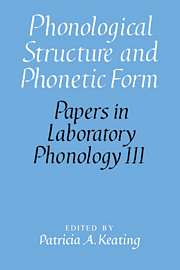Book contents
- Frontmatter
- Contents
- List of contributors
- Acknowledgments
- 1 Introduction
- I Intonation
- II Syllables
- III Feature Theory
- IV Phonetic Output
- 16 Phonetic evidence for sound change in Quebec French
- 17 Polysyllabic words in the YorkTalk synthesis system
- 18 Phonetic arbitrariness and the input problem: comments on Coleman's paper
- 19 Lip aperture and consonant releases
- 20 Change and stability in the contrasts conveyed by consonant releases
- Index of subjects
- Index of names
19 - Lip aperture and consonant releases
Published online by Cambridge University Press: 26 February 2010
- Frontmatter
- Contents
- List of contributors
- Acknowledgments
- 1 Introduction
- I Intonation
- II Syllables
- III Feature Theory
- IV Phonetic Output
- 16 Phonetic evidence for sound change in Quebec French
- 17 Polysyllabic words in the YorkTalk synthesis system
- 18 Phonetic arbitrariness and the input problem: comments on Coleman's paper
- 19 Lip aperture and consonant releases
- 20 Change and stability in the contrasts conveyed by consonant releases
- Index of subjects
- Index of names
Summary
Introduction
The focus of this paper is, simply put, how the mouth is opened during vowels in CV (sub)syllables. Such a question is intimately related to the nature both of consonant releases and of lip control (as in rounding). The function of controlling the lips for vowels might be to ensure that the mouth is open during the vowel, so that there will be radiated sound. If this is the case, then actively controlled consonant-release movements, which would serve the same purpose, might not be necessary; the mouth might open sufficiently, given the lip control, if the consonant is simply turned off without actively moving away from its position of closure.
Much previous work has viewed the relation between consonants and vowels as a linear phenomenon. In a CV syllable or subsyllable, the consonant is considered to occur first, followed by the transition from the consonant into the vowel, and finally the vowel. In the acoustic instantiation of such a perspective, the transition from consonant to vowel often consists of two parts, at least for plosives: a burst (plus any aspiration) followed by formant transitions (e.g. Cooper et al. 1952; Fant 1973). The importance of the acoustic properties of the release for characterizing stop consonants has been emphasized by authors such as Stevens and Blumstein (1981).
However, it is in fact not possible to separate consonantal and vocalic information temporally. As emphasized by Liberman et al. (1967), both the burst and the formant transitions are affected by both the vowel and the consonant, due to the overlapping articulations involved. Articulatorily, consonants and vowels are not linearly organized.
- Type
- Chapter
- Information
- Phonological Structure and Phonetic Form , pp. 331 - 353Publisher: Cambridge University PressPrint publication year: 1994
- 1
- Cited by



